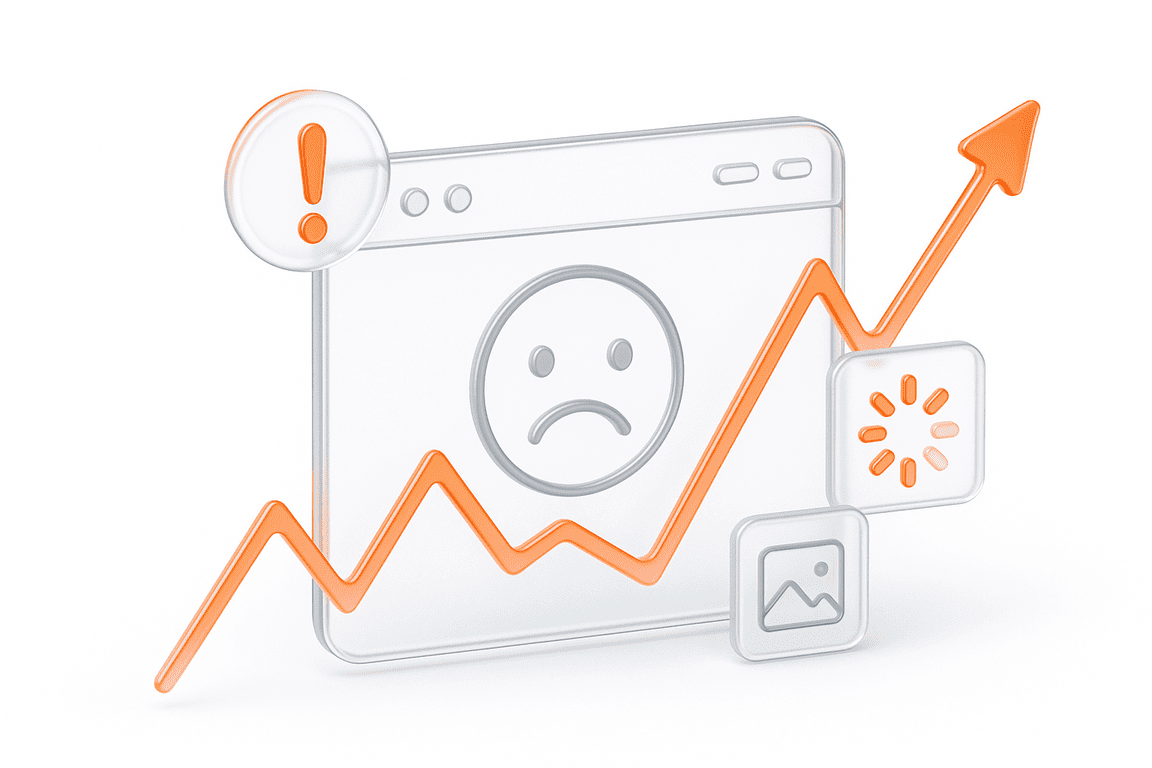Imagine your application is running smoothly until a flash sale or unexpected traffic surge hits. Suddenly, users can’t log in, pages stop loading, and your team is scrambling to restore service. These unpredictable spikes can overwhelm even the most robust systems if you’re not prepared.
Spike testing is the method used to simulate these sudden load bursts and uncover how your application handles them. In this guide, we’ll walk through what spike testing is, its benefits and limitations, how it compares to other testing types, and how solutions like PFLB help companies stay stable under pressure.
What Is Spike Testing?
Spike testing is a type of performance testing used to evaluate how a software application reacts to a sudden and sharp increase, or decrease, in user load. Unlike gradual load tests, spike testing focuses on simulating abrupt traffic changes to understand how the system performs during and after the spike.
The primary goal of spike performance testing in performance testing is to observe the application’s stability and response time under pressure, as well as how quickly it can recover once the load drops back to normal. This approach helps identify weak points in the system that could cause slowdowns, errors, or complete failure during peak demand.
To carry out a spike test, teams use a dedicated testing environment, never a live production system. Tools like Apache JMeter or other performance simulators are commonly used to apply sudden bursts of virtual users to the system. The load is ramped up and down quickly to mimic real-life usage fluctuations, and performance graphs are analyzed to see where and how the system might break.
This type of testing not only helps assess application behavior at its limits but also provides valuable data for scalability planning and resource management.
Main Objectives of Spike Testing
The main objective of spike test is to ensure your software doesn’t fall apart when faced with sudden and extreme shifts in user activity. While most applications are built and tested for steady performance, real-world usage often brings unpredictable traffic patterns, especially during flash sales, viral moments, or product launches.
Here are the key goals of a spike test:
Each of these objectives is critical in planning for long-term application performance, especially when downtime can lead to revenue loss or damaged brand reputation.
Spike Testing: Pros and Cons
| Advantages | Disadvantages |
| Detects early signs of performance bottlenecks | Spike scenarios may not reflect realistic usage patterns |
| Optimizes resource allocation for unexpected load surges | Complex to design and simulate accurately |
| Ensures system availability during sudden traffic peaks | Does not test sustained or gradually increasing load |
| Supports disaster recovery and incident response planning | Requires a dedicated test environment and monitoring tools |
| Helps plan infrastructure scaling for seasonal or event-driven demand | Resource-heavy and potentially costly for smaller teams |
| Builds confidence in both the system and the operations team | Can lead to over-provisioning if used without context from other testing methods |
Advantages of Spike Testing
Spike testing uncovers performance vulnerabilities that often go unnoticed in traditional testing scenarios. It pushes your system to its limits, revealing how well your infrastructure and application can handle unpredictable, real-world spikes in usage.
Here are the main benefits of spike testing:
By running spike tests regularly, teams gain the clarity they need to reinforce both frontend and backend systems against sudden load surges.
Disadvantages of Spike Testing
While spike testing is valuable, it’s not without its limitations. Like any testing method, it should be part of a broader performance testing strategy, not the only approach. Understanding its drawbacks can help teams design more effective and realistic test scenarios.
Here are the main challenges of spike testing:
Despite these drawbacks, the insights gained from spike testing are often worth the investment, especially when availability and responsiveness are mission-critical.
Spike Testing vs. Load Testing vs. Stress Testing
While all three testing types fall under the umbrella of performance testing, they serve different purposes and simulate distinct real-world conditions.
Each method, load, stress, or spike load testing, offers unique insights for building high-performance systems. Understanding when and how to use each is essential for building a resilient, scalable application.
Spike Testing
Spike testing evaluates how an application reacts to a sudden and extreme surge or drop in user load. The focus is on how quickly and efficiently the system can respond and recover from unexpected bursts of traffic. This type of testing is ideal for scenarios like flash sales, viral campaigns, or unplanned usage spikes.
Load Testing
Load testing measures how well a system performs under expected levels of concurrent users or transactions over time. It helps identify whether the application meets performance benchmarks such as response time, throughput, and stability.
Stress Testing
It’s common to confuse spike testing vs stress testing, as both involve pushing systems to their limits. The difference lies in the pattern; spike testing triggers an abrupt traffic surge, while stress testing gradually increases load until the system fails.
Stress testing pushes an application beyond its limits to determine how and when it fails. The aim is to discover the breaking point and evaluate the system’s stability and recovery under extreme conditions.
By combining all three, spike, load, and stress testing, organizations can build a complete picture of system performance and resilience, from everyday use to worst-case scenarios.
Comparison Table: Spike Testing vs. Load Testing vs. Stress Testing
| Aspect | Spike Testing | Load Testing | Stress Testing |
| Purpose | Test sudden traffic changes | Check steady performance | Push to max capacity |
| Load Pattern | Sharp spikes or drops | Gradual, steady increase | Continuous rise until failure |
| Focus | Recovery and stability | Speed and resource use | Failures and recovery |
| Test Duration | Short bursts | Sustained load | Longer, escalating load |
| Scenario | Flash sales, viral events | Normal daily usage | Peak season, high traffic stress |
| Risk Areas | Recovery issues, instability | Slowdowns under load | Crashes, data loss, server failure |
| Tools | JMeter, LoadRunner, Gatling | JMeter, BlazeMeter, LoadNinja | JMeter, NeoLoad, LoadRunner |
| When to Use | Before sudden demand events | Routine performance checks | Disaster readiness, capacity testing |
Spike Testing Process
To get meaningful results from a spike test, you need more than just a traffic simulator, you need the right setup, clearly defined limits, and detailed analysis. Here’s how a proper spike testing process works step by step:
1. Set Up the Test Environment
Always run spike tests in a dedicated testing environment, not in production. This ensures accurate results without risking downtime for real users. Your test setup should closely reflect your production infrastructure, including hardware, network conditions, and configurations.
2. Determine the Extreme Load Limit
Identify the traffic thresholds you want to test against, this could be 2x, 5x, or even 10x your typical traffic. Use historical data or peak event forecasts to set realistic, but challenging, load levels.
3. Apply Peak Load Abruptly
Use tools like JMeter or PFLB to instantly apply a massive increase in user traffic. This spike should occur without a gradual ramp-up, mimicking scenarios like sudden media exposure or flash sales.
4. Observe System Behavior at Peak Load
Monitor how your application handles the surge. Look for red flags like increased response times, memory leaks, CPU spikes, or service interruptions. Real-time monitoring tools are essential here.
5. Drop Load Abruptly to Minimum
After maintaining peak load for a short period, quickly reduce the load to normal or near-zero levels. This tests how well your system recovers and rebalances resources after stress.
6. Watch Recovery
The post-spike phase is just as important. Some systems don’t crash during the spike but start misbehaving afterward. Monitor for lingering issues, such as slow database queries, memory leaks, or degraded user experience even after traffic normalizes.
7. Analyze Results
Pull all your logs, graphs, and metrics to conduct a thorough analysis. Identify failure points, bottlenecks, and abnormal behaviors. Use this data to patch weak spots, optimize code, or improve auto-scaling policies before you go live.
How PFLB Supports Businesses with Spike Testing
Spike testing is about knowing what to look for, how to interpret the results, and how to make improvements that matter. That’s where PFLB brings real value.
With over 15 years in performance testing, PFLB has helped global enterprises across fintech, telecom, eCommerce, and healthcare prepare their systems for unexpected demand. Our team combines hands-on experience, custom testing frameworks, and real-time analysis to ensure your applications stay stable when it counts most.
Why Companies Choose PFLB:
Final Thought
Unexpected traffic surges are a reality for any growing digital platform. Without proper preparation, they can expose serious performance gaps at the worst possible moment. Spike testing in software testing offers a practical way to evaluate how well your application handles these scenarios, both during the spike and after traffic returns to normal.
By identifying bottlenecks, observing system behavior under pressure, and assessing recovery capabilities, spike testing becomes a key part of building resilient, scalable systems. Combined with other performance testing methods, it ensures your application is ready, not just for typical usage, but for the moments that matter most.
If your system hasn’t been tested for moments like that, now’s a good time to start.
Related insights in blog articles
Professional vs. In-House Website Load Testing: Which One Do You Really Need?

Thriving in the fierce digital space is what every business strives for. While high-traffic events like targeted marketing campaigns, paid ads, product launches, and seasonal spikes certainly help win over customers and skyrocket sales, they also abruptly expose hidden website vulnerabilities to users. To assess website readiness for traffic surges and prevent weaknesses, such as […]
How Website Performance Impacts E-Commerce Sales and Cart Abandonment

Every e-commerce store has mere milliseconds to make the right impression on shoppers. When prospects land on a product page, they assess every single metric, and e-commerce website performance and speed are the most critical ones. In most scenarios, impatient users will bounce instantly — at the slightest hint of latency caused by high loads […]
10 Signs Your Website Can’t Handle Traffic Spikes: Everything you need to know

Your campaign goes live, clicks start pouring in, and traffic shoots up fast. It’s the moment you’ve been waiting for, until everything slows down. Pages take ages to load, checkout freezes, and visitors disappear before they can buy. It’s a frustrating twist: the success of your marketing draws in more people than your website can […]
Why Averages Lie: Mathematical Methods for Load Testing

Relying on “average” metrics alone makes load testing surprisingly inaccurate. In this article, we’ll show how to avoid the usual traps and walk through practical techniques for mathematically modelling a workload profile, from analyzing variance and correlations to spotting Simpson’s paradox and validating the final model. When a company moves to a new system, the […]
Be the first one to know
We’ll send you a monthly e-mail with all the useful insights that we will have found and analyzed
People love to read
Explore the most popular articles we’ve written so far
- Top 10 Load Testing Tools for 2025: The Deep Dive Sep 9, 2025
- Cloud-based Testing: Key Benefits, Features & Types Dec 5, 2024
- Benefits of Performance Testing for Businesses Sep 4, 2024
- Android vs iOS App Performance Testing: What’s the Difference? Dec 9, 2022
- How to Save Money on Performance Testing? Dec 5, 2022

